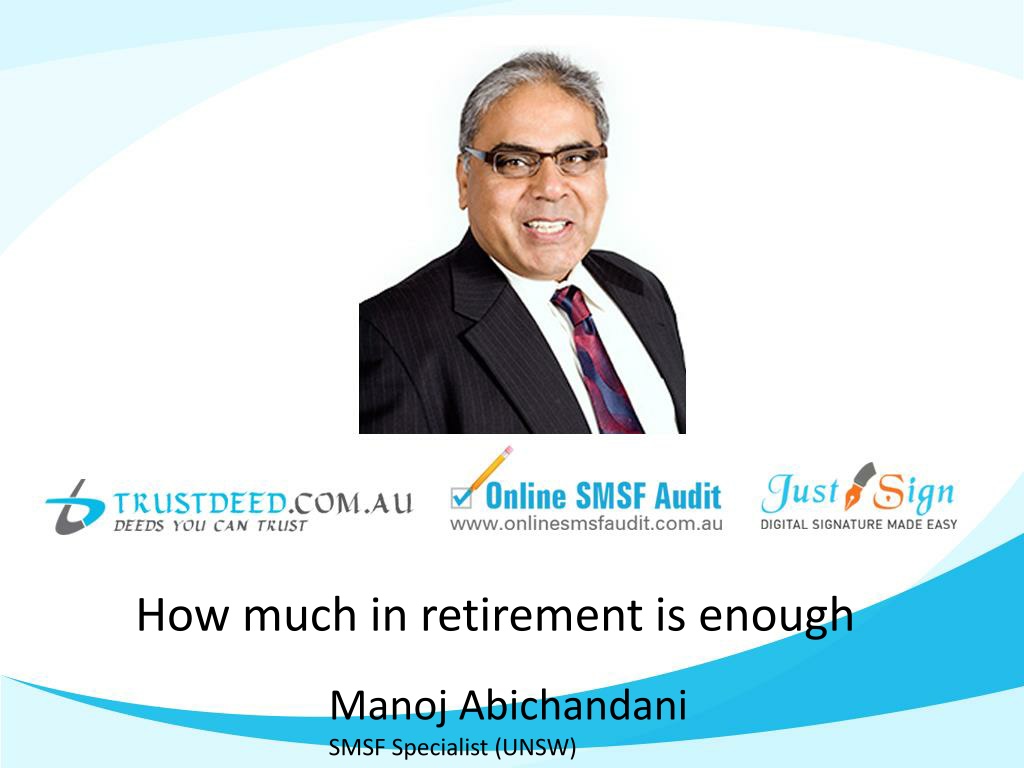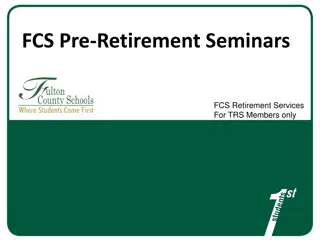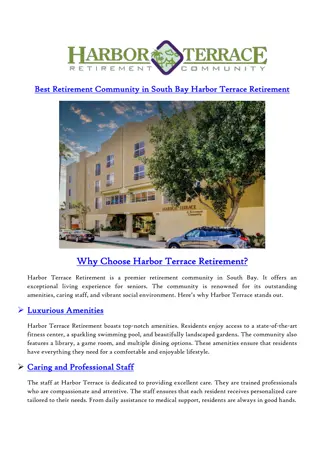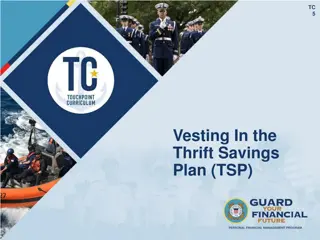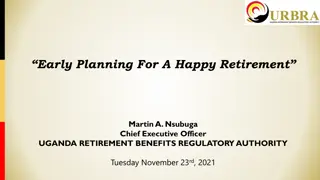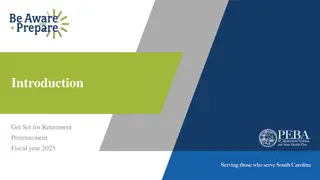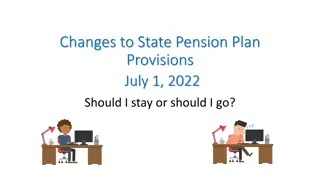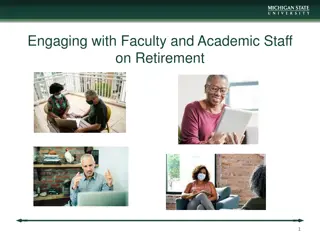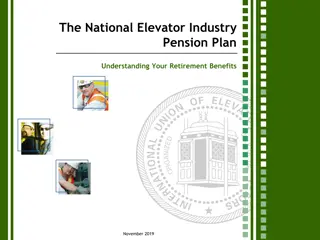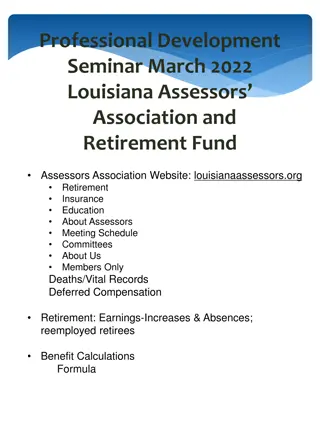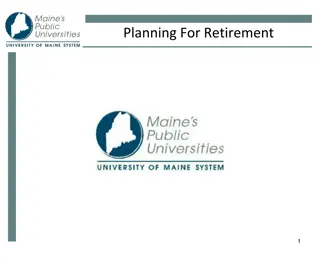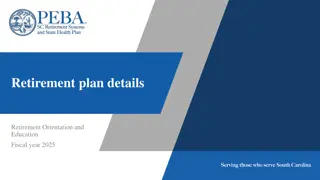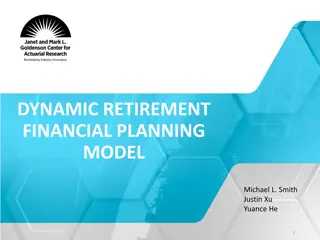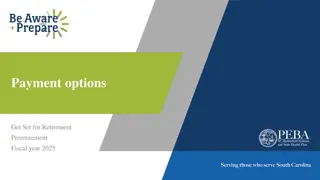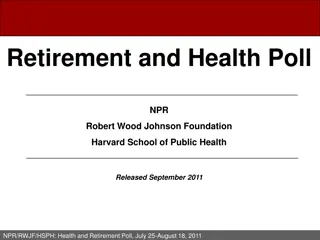Determining Your Retirement Savings Goal
Planning for retirement can seem daunting, but understanding how much you need is crucial. Manoj Abichandani, SMSF Specialist at UNSW, explores key considerations such as saving versus spending income, the impact of paying off a home loan, differentiating between asset growth and income generation, knowing when to stop passive income, and the importance of giving to heirs. Take control of your financial future by assessing your retirement needs today.
Download Presentation

Please find below an Image/Link to download the presentation.
The content on the website is provided AS IS for your information and personal use only. It may not be sold, licensed, or shared on other websites without obtaining consent from the author. Download presentation by click this link. If you encounter any issues during the download, it is possible that the publisher has removed the file from their server.
E N D
Presentation Transcript
How much in retirement is enough Manoj Abichandani SMSF Specialist (UNSW)
House Keeping - Audio If Computer sound is not audio able 1. Phone the number on your panel 2. Enter Access Code
House Keeping Hand Out Copy of this Presentation can be downloaded From the Panel
House Keeping Questions on this Presentation If you have any Questions on this Presentation 1. Type in your questions in the panel 2. Speaker will answer all your questions after the presentation
Disclaimer of Legal & Financial Advice Educational Purpose Only Statement This paper represents the opinion of the author (s) and not necessarily those of Deed Dot Com Dot Au Pty Ltd. The contents are for general information only. They are not intended as professional advice - for that you should consult a Accountant or other suitably qualified professional. Deed Dot Com dot Au Pty Ltd expressly disclaims all liability for any loss or damage arising from reliance upon any information in this presentation. Disclaimer The information contained in this presentation is based on the understanding of the author has of the relevant Australian laws as at 27th December 2021. As these laws are subject to change you should refer to ATO s website or talk to a professional adviser for the most up-to-date information. The information is for adviser use only and is not a substitute for investors seeking advice. While all care has been taken in the preparation of this document (using sources believed to be reliable and accurate), no person, including Deed Dot Com Dot Au Pty Ltd, accepts responsibility for any loss suffered by any person arising from reliance on this information. This update is not financial product advice and does not take into account any individual s objectives, financial situation or needs. Any examples are for illustrative purposes only and actual risks and benefits will vary depending on each investor s individual circumstances. You should form your own opinion and take your own legal, taxation and financial advice on the application of the information to your business and your clients. Manoj Abichandani is NOT a financial planner or a Tax Agent and this presentation should not be construed as Tax or Financial advice
Agenda How much in retirement is enough 1. Save VS Spend Income Which one? 2. Paying off the Home Loan Good or Bad 3. Some assets grow and some give income - Land 4. When to stop passive income when you have enough 5. Give to kids with a warm hand
Today / Tomorrow Accumulating Retirement Tomorrow Today AGE Working for money Working not for money
Today / Tomorrow Accumulating Retirement Tomorrow Today AGE Working : for money Working : not for money
These people will delay your retirement Tax man Bank man Employer
These people will delay your retirement Tax man = pay less tax Bank man = fool him Employer = Get rid of him, if you can
How do you pay less Tax Earn Less Taxable Income
Tax man = pay less tax Tax man will tax you more if your income is more Taxable income Tax on this income 0 $18,200 Nil $18,201 $45,000 19 cents for each $1 over $18,200 $45,000 - $18,200 = $26,800 x 19% = $5,092 $45,001 $120,000 $5,092 plus 32.5 cents for each $1 over $45,000 $120,001 $180,000 $29,467 plus 37 cents for each $1 over $120,000 $180,001 and over $51,667 plus 45 cents for each $1 over $180,000
Some Facts 1. If you earn more than $1 more than $45,000 Tax man will come and take away 32.5% plus 2% Medicare Levy more than 1/3rd of your income 2. Tax rate of companies is only 25% 3. If you have a company = you will pay less tax (does not apply to employees due to PSI rules) Table: Progressive changes to the company tax rate Tax rate for base rate entities under the threshold Aggregated turnover threshold Tax rate for all other companies Income year 2020 21 $50m 26.0% 30.0% 2021 22 and future years $50m 25.0% 30.0%
But $45,000 Income is not enough $45,000 less tax $5,000 (exact figure $5,092) = $40,000 x 2 (H & W Working) = $80,000 Or Can you spend $1,538 per week What about my home loan!
Do you own the home if you own only 20% Address = Bella Vista Land = 700 Sq Meters House = 40 Squares 20% = 8 Squares or say 70 Sq Meter You = say Formal Lounge Bank = Rest of the house
Land Bella Vista 16/12/21 15/11/21 17/10/20 04/09/19 14/08/15 03/04/14 08/08/12 01/09/11 11 Pipersbrook Crs. 35 Ernesta Pl 32 Brighton Dr. 26 Charlemont Tr 3 Chamonix Pl 76 Edgewater Dr 16 Charlemont Tr 24 Brighton Dr. 704.5Sq M 725Sq M 753 SqM 700 SqM 800 Sq M 750SqM 788 Sq M 763Sq M $2.7M $2.635M $1.835M $1.49M $1.3M $900K $592K $585K
House Prices: Bella Vista 14/12/21 13/12/21 31/10/21 15/10/21 13/09/21 35 Bella Vista Dr. 19 Prestige Ave 10 Waddell Rd 12 Waterfall Crs. 12 Pipersbrook Crs 788 SqM 710 SqM 722 SqM 863 SqM 703SqM $2.35M $2.57M $3.22M $2.80M $2.84M
Is it better to Land Bank? 12 Pipersbrook Cres. Sold $2.84M Sold $2.25M Sold $1.21M 13/09/21 01/09/15 12/03/06 11 Pipersbrook Cres. Sold $2.7M Sold $2.4M Sold $685K 16/12/21 01/7/21 01/09/12
Negative Gearing Rule of Thumb: House of $500,000 generates $500 rent per week = it takes 1,000 weeks or about 19 years to recover the cost You have to borrow to build a house Loan of $500,000 @3.29 Fixed Rate is $2,188 per month for a 30 year loan After 19 years the house is not worth a lot as new building styles come Renting a house is the worst investment decision Many areas you can buy an old house at land value the adage: worst house in the best street A brand new house on land should be sold as soon as it is built and not rented out A 0% return on Land (besides holding costs) is better than Negative return on a house Rich people always land bank and never rent out
Some of the lessons which I have learnt Residential Property: 1. Buying land is better than buying a house it grows quicker 2. Rental return is very low 3. Property Depreciates Land Appreciates 4. Almost always results in Negative Gearing due high amount of loan to build the house 5. If Value goes up by $200,000 per year it is growing @$4,000 per week there is no need for annual return (rent) Commercial Property: 1. There can be multiple uses to commercial land 2. Beauty is in the eyes of the beholder you see Dirty Tyre shop I see Spanking KFC 3. Give rent-free period to get more rent for a better yield higher yield results in better price 4. Tennant is responsible for all repairs
Bank man = fool him (most of them are not smart they just follow the tick boxes) What about my home loan!
Situation Home Bella Vista Value Today Purchased in 2020 for Loan Equity Today $2.5M $2.3M (Banks Value) $1.2M (Sold a house before) $1.3M Bank needs 20% of Valuation or $2.5M X 20% = Extra Equity $500K $800K -------- $1.30M Total Equity
How to fool the bank man Don t pay Principal and don t pay Interest 4 Year Fixed Principal + Interest Loan Term 30 Years Interest Rate 3.29% Monthly Instalments $5,249 1 Year = $5,249 x 12 = $62,988 4 Years $62,988 X 4 = $251,952 10 Years $62,988 x 10 = $629K Home Loan 1 $1.2M Home Loan 2 Extra Equity $800K Interest on 2nd Loan $116,822* Total of Loan 2 after 10 Years = $746,702 @ 3.29% = $805,241 @5% after 4 Yr fixed period *Refer to Spreadsheet
After 10 years of Home Loan 1 and Home Loan 2 Home Loan 1 Home Loan 2 Total Loans $1,2M $0.8M $2.0M Value in 2021 $2.5M Value in 2031 Value Bank Equity (20%) Extra Equity 10% 2.75 0.55 200K 400K 600K 800K 1.0M 2.0M 20% 3.00 0.60 30% 3.25 0.65 40% 3.50 0.70 50% 3.75 0.75 100% 5.00 1.00
Some of the lessons which I have learnt 1. 2. 3. 4. There is no need to pay Principal or Interest to the bank You should payback nothing to the bank Most rich people have big loans $1500 per week is enough for a family who has no home loans to pay There is no need to have taxable income greater than $45,000 5. If you earn a salary package is $110,000 what should you do with the balance $65,000 after $45,000 taxable income Since we do not need it for today put it in tomorrows pocket = Superannuation
What do the bank and Govt. Wants us to do? https://moneysmart.gov.au/home-loans/pay-off-your-mortgage-faster Avoid an interest-only loan Paying both the principal and the interest is the best way to get your mortgage paid off faster. Most home loans are principal and interest loans. This means repayments reduce the principal (amount borrowed) and cover the interest for the period. With an interest-only loan, you only pay the interest on the amount you've borrowed. These loans are usually for a set period (for example, five years). Your principal does not reduce during the interest-only period. This means your debt isn't going down and you'll pay more interest. Make higher repayments Another way to get ahead on your mortgage is to make repayments as if you had a loan with a higher rate of interest. The extra money will help to pay off your mortgage sooner. If you switch to a loan with a lower interest rate, keep making the same repayments you had at the higher rate. If interest rates drop, keep repaying your mortgage at the higher rate. Make extra payments Extra repayments on your mortgage can cut your loan by years. Putting your tax refund or bonus into your mortgage could save you thousands in interest. On a typical 25-year principal and interest mortgage, most of your payments during the first five to eight years go towards paying off interest. So anything extra you put in during that time will reduce the amount of interest you pay and shorten the life of your loan. Ask your lender if there's a fee for making extra repayments. https://www.nab.com.au/personal/life-moments/home-property/pay-off-home- loan/should-i-pay-off Reminder I am not a financial planner I am just showing you how I do things for myself and NOT suggesting that you should follow me
How much deductible amount we can we put into Super Compulsory Employer should put 10% of Wages Maximum Concessional cap amount (This is what your accountant will tell you) $27,500 After Tax (non-concessional) every year cap amount $110,000 Maximum you can put in Super every year is $137,500 (As any amount above the concessional cap amount is counted towards the non-concessional cap amount)
If $110,000 is salary Package How to maximise super with $110,000 Income Income 110000 Wages 45,000 Super Contribution 56,400 Tax 5,092 Tax in Super In Super after Tax Concessional Contribution 8,460 $47,940 27,500 Extra to pay Tax Tax @34.5% 8,600 2,967 Extra Concessional Contribution 28,900 Cash To pay Excess Contribution Tax Amount 5,633 Added to your Income Extra Tax to be paid Less Already Paid in Super Extra Tax to be paid outside Super 34.5 15 19.5 Total Taxable Income 53,600 How much to put in Super is Financial Advice Warning: I am not a financial Planner Tax to be paid for extra Concessional Contribution 5635.5
How does super grow in the fund Amount of Contribution Rate of Return How long has the money been in Super The fees which is being charged to the fund (Average MER is about 1.4% - Industry Fund 0.65% - a $1,000,000 pays $6,500 in an Industry Fund)
The 10 top super funds in APRAs performance test https://www.afr.com/policy/tax-and-super/the-10-top-performing-super-funds-in-apra-s-performance- test-20211217-p59ie9 7-year net investment return Fund* Product Test score Fund type Unisuper Balanced 1.5 9.22% Industry Australian Ethical Retail Superannuation Fund Balanced (accumulation) 1.3 9.00% Retail AustralianSuper MySuper 1.2 9.65% Industry QSuper Lifetime 1.2 3.84-9.48% Public sector Cbus MySuper 1.1 9.34% Industry Hostplus Balanced 0.9 9.50% Industry Statewide MySuper 0.8 8.93% Industry First Super MySuper 0.8 8.39% Industry Care Super CareSuper 0.7 8.68% Industry Aware Super MySuper Lifecycle 0.7 6.86-8.66% Public sector
How does super grow in the fund - Amount of Contribution Minimum 10% Employer Contribution - $10,000 return 2% after fees Income Contribution $ Value Age 65 $508K 70 $597K 50 $280K 55 $350K 60 $425K 35 $104K 45 $216K 25 30 $54K
How does super grow in the fund - Amount of Contribution Minimum 10% Employer Contribution - $10,000 return 6% after fees Income Contribution $ Value Age 65 $1.18M 70 $1.56M 50 $467K 55 $649K 60 $882K 35 $128K 45 $325K 25 30 $61K
How does super grow in the fund - Amount of Contribution Max Concessional Contribution - $27,500 return 6% after fees Income Contribution $ Value Age 65 $3.24M 70 $4.32M 50 $1.24M 55 $1.74K 60 $2.42M 35 $353K 45 $895K 25 30 $168K
How does super grow in the fund - Amount of Contribution Recommended Contribution - $56,400- return 6% after fees Income Contribution $ Value Age 65 $6.6M 70 $8.8M 50 $2.6M 55 $3.6M 60 $4.9M 30 $346K 35 $725K 45 $1.8M 25
How does super grow in the fund - Amount of Contribution Recommended Contribution - $56,400- at age 50 return 6% after fees Income Contribution $ Value Age 65 $1.65M 70 $2.4M 50 $200K 55 $616K 60 $1.07M 30 $100K 35 $125K 45 $150K 25
How does super grow in the fund - Amount of Contribution Recommended Contribution - $56,400- at age 50 return 10% after fees Income Contribution $ Value Age 65 $2.4M 70 $3.9M 50 $200K 55 $718K 60 $1.39M 30 $100K 35 $125K 45 $150K 25
SMSF Statistical Report June 21 Table 8.1: Proportion of funds, by asset range of fund Asset Ranges $0 to $50,000 >$50,000 to $100,000 >$100,000 to $200,000 >$200,000 to $500,000 >$500,000 to $1m >$1m to $2m >$2m to $5m >$5m to $10m >$10m to $20m >$20m to $50m >$50m Total 2019 20 4.9% 2.7% 6.6% 22.3% 25.8% 20.7% 13.4% 2.8% 0.7% 0.1% <0.1% 100% 2018 19 5.9% 3.1% 7.0% 22.1% 24.8% 20.1% 13.2% 2.9% 0.7% 0.1% <0.1% 100% 2017 18 5.9% 3.4% 7.8% 23.0% 24.5% 19.5% 12.5% 2.6% 0.7% 0.1% <0.1% 100% 2016 17 6.1% 3.8% 8.5% 23.5% 24.2% 19.0% 11.9% 2.5% 0.6% 0.1% <0.1% 100% 2015 16 6.3% 4.3% 9.3% 24.4% 24.1% 18.1% 10.9% 2.2% 0.4% 0.1% <0.1% 100% Approx 600,000 funds of which 3.6% or 21,600 funds with more than $5M
ATO knows we are there. Medium and emerging private groups The medium and emerging private groups include: private groups linked to an Australian resident individual who, together with their associates, control wealth between $5 million and $50 million Australian businesses with annual turnover of more than $10 million that are not public or foreign-owned and not linked to a high wealth private group. Medium and emerging private groups represent the majority of total private groups. We use enhanced data and analytics to understand the operating environment of these groups, identify and address tax risks and design tailored approaches to mitigate those risks. https://www.ato.gov.au/Business/Privately-owned-and-wealthy-groups/What- you-should-know/Tax-performance-programs-for-private- groups/#Highwealthprivategroups
When do you pay the home loan Tax in Super is 15% Individual Tax Rate 34.5% between $45,000 to $120,000 Cost of paying $1,000 back to bank Outside of Super 1000 x 100/65.5 $1,526.71 52.67% From Super (after Age 60) 1000 x 100/85 $1,176.47 17.64% To Pay $3,000,000 back to the bank $4,580,152 $3,529,411
Set up of SMSF Not for Everyone Can be cheaper to run You have investment responsibilities You have to good with paperwork Compliance Must hire a specialist SMSF Accountant Can cost between $2000 to $4000 per year to run Must have at least $200,000 (APRA + ASIC + ATO) before you consider starting one You can buy anything shares / property / Land You cannot do many things loan to members / relatives / cannot live in the house owned by SMSF but can rent commercial property
How do you get 10% or more return in SMSF Land for Sale Growth Asset Trustees Security Own Home
How do you fund these purchases PCG 2016/5 Land for Sale Growth Asset 70% Loan 30% Deposit Trustees I n t e r e s t contribution Employer Security
Some of the Lessons which I have learnt Start contribution to super early in age Aim for a better return if possible 10% Do not pay anything to the bank Reduce cost of managing super SMSF Pay off the Home Loan when 60 from SMSF when retired Growth Asset to be purchased Only in SMSF No Negative Gearing All Assets only in SMSF Only own home outside of Super Accumulate wealth in Super
How much in Super is enough The lifestyle you want Think about how you plan to spend your money in retirement. If you own your own home, a rule of thumb is that you'll need two-thirds (67%) of your pre- retirement income to maintain the same standard of living in retirement. The Association of Superannuation Funds of Australia (ASFA) provides an industry retirement standard. This estimates how much money you'll need, depending on your lifestyle. https://moneysmart.gov.au/grow-your-super/how-much-super-you-need Source: ASFA, June quarter 2021 ASFA Retirement Standard Comfortable lifestyle Modest lifestyle Single $44,818 a year $859 a week $28,514 a year $546 a week Couple $63,352 a year $1,214 a week $41,170 a year $789 a week
How much in Super is enough In my opinion 200% or $3,000 per week or $150,000 Capital for 5% return or times 20 $150,000 (Fruit) x 20 = $3,000,000 (Tree) Or say up to $1.7M each which is Transfer Balance Cap the maximum which you are allowed to earn without paying any tax in Super Total Super required is $3,400,000 plus $3,000,000 to pay off the home loan
What happens to super when you die (Tree) Goes to spouse reversionary pension When 2nd spouse dies goes to dependents if any or to adult children You must withdraw from super before 2nd spouse is ready to die or adult kids will pay 15% + 2% Medicare Levy on Concessional Contribution and income of the fund Give it to the kids so that they can build their own super
Is superannuation controlled by a will - No Section 302-195 of Income Tax Act tells us who can be paid a death benefit Parents and siblings can get paid via an estate Only tax dependents (spouse or kids under 18 etc )can get tax free death benefits Adult children will pay tax when they receive super death benefits Binding death benefit nomination is given by member to the Trustee of the fund > Legal Personal Representative > Trustee of estate can get money from super to be distributed via a will Testamentary Trust can be set up > date of death of the member
When one of two spouses die In retirement - most likely some super will come out of the super system When the 2nd spouse dies = all super comes out How this super is taxed is the key to the whole game going forward
How much super can we have There is no limit on how much super we can have Non- Concessional Contributions are allowed up to your super reaches $1.7M $1.7M + downsizer Contributions Small Business Capital Gains tax Contributions Growth in super due to income
